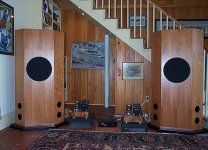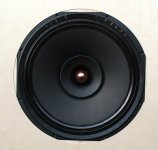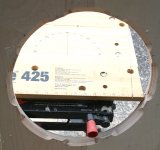Member
Joined 2009
Paid Member
This is what a GRF/Westminster is like.
Seriously unlikely the Nirvana drivers are fit for these, but at least look at what is Time proven.
Rick's Tannoy Autograph Enclosures
these look really nice and quite a fun project too. But 20+ weeks of work (weekends and evenings) sounds like a lot - I think I'd want to hear one of these beasts before starting it.
I would be very intereted in this. Green Glue gets expensive real quick in the quantities needed to be useful in cabinet construction.
Tell me more........
blakktie
It's really simple. Look up the MSDS for this glue and you'll see it's nothing more than Latex. You can buy latex at the local hardware store. There are different densities, manufacturers often load them with chalk (calcium carbonate) and MSDS sheets usually only give a range of values not exact formula. But you can work out the density from the size and weight of the glue.
you want to get pva wood glue then add around 1:1 ratio of glue and talc mix thorougly, you then might need to thin it out a bit use 50/50 water and methylated spirits mix if thinning is required.. Make up a small quantity first and spread it over a piece of spare wood to see what it is like. Report back
Last edited:
Member
Joined 2009
Paid Member
PVA is the wrong stuff - it sets hard. This is the last thing we want if we're creating a constrained layer barrier. We need the latex. I'm not sure whether the chalk is needed in order to get good performance from the glue. It adds some mass, but that's not the point of this exercise, where you want a thin layer of viscoelastic material. You only need enough glue to get good coverage - too much and the performance actually gets worse. So perhaps some good latex glue from the local store is just fine of itself ?
Karlson - I've never considered this option, never fancied having a Plumber in my living room.
Karlson - I've never considered this option, never fancied having a Plumber in my living room.
um
the 12" AN CF in the 5.6 enclosure made with 20mm plywood sound pretty good. they have a 15cm diameter vent hole.
not sure why the 1mm xmax troubles some people, this is a 15" driver we're talking about.
my 12" at 0.5mm has so much output at 40Hz that makes me nauseated. I would not want to listen to the 15" at 1mm.
am i missing something you guys?
the 12" AN CF in the 5.6 enclosure made with 20mm plywood sound pretty good. they have a 15cm diameter vent hole.
not sure why the 1mm xmax troubles some people, this is a 15" driver we're talking about.
my 12" at 0.5mm has so much output at 40Hz that makes me nauseated. I would not want to listen to the 15" at 1mm.
am i missing something you guys?
Member
Joined 2009
Paid Member
Heres a mere 10.3cuft enclosure for a 15" Tannoy DC (not mine)
Ive had 15" DC's in the berkerly cabinet with 100W of solid state class A power up their back ends - the result was beautiful and I'm still in love with big drivers
As for the Xmax of 1mm (each way). It really doesn't matter. I'm using 12LTA's in the Emken and with barely any movement of the cone they are at thunderous levels.
This AN driver in a 10cuft+ box will literally shake everything. I hope you have a big room Bigun so the modes where it gets excited will support the really low stuff. I rattled glasses in all four apartments on my floor on a test run (with owners permission) with the Tannoys
If you want to scare the poop out of yourself and make every hair on your body stand to attention, play track 2 The Wheat into track 3 The Battle from the Gladiator soundtrack at near full whack


Ive had 15" DC's in the berkerly cabinet with 100W of solid state class A power up their back ends - the result was beautiful and I'm still in love with big drivers
As for the Xmax of 1mm (each way). It really doesn't matter. I'm using 12LTA's in the Emken and with barely any movement of the cone they are at thunderous levels.
This AN driver in a 10cuft+ box will literally shake everything. I hope you have a big room Bigun so the modes where it gets excited will support the really low stuff. I rattled glasses in all four apartments on my floor on a test run (with owners permission) with the Tannoys
If you want to scare the poop out of yourself and make every hair on your body stand to attention, play track 2 The Wheat into track 3 The Battle from the Gladiator soundtrack at near full whack
Attachments
PVA is the wrong stuff - it sets hard. This is the last thing we want if we're creating a constrained layer barrier. We need the latex. I'm not sure whether the chalk is needed in order to get good performance from the glue. It adds some mass, but that's not the point of this exercise, where you want a thin layer of viscoelastic material. You only need enough glue to get good coverage - too much and the performance actually gets worse. So perhaps some good latex glue from the local store is just fine of itself ?
Karlson - I've never considered this option, never fancied having a Plumber in my living room.
When it is thin it apearrs to be hard but actually it is quite soft and flexible, this becomes very apparent when you use thick coatings. I also agree filling it up with pigment is probaby not going to do much except add mass and do very little in terms of increasing performance.
If you want something better than that I can make something from scratch using polyurethane.
You want about 1mm thick, for it to be effective. I think it might be hard trying to achieve even levelling of the 2 panels of wood.
We usually use pre-made materials for the job, because you are guaranteed uniform and correct thickness. Putting a liquid between 2 panels and hoping you get the right thickness evenly distributed is a bit tricky. You need at least 500um and that is bloody difficult to achieve at home. I suspect you will have a lot of trial and error and end up having useless pieces of wood.
Get the right materials for the job. Use premade viscoelastic rubbers, vinyls or possibly even cork. But it has to be around 500um to 1mm thick. They also come already with a contact adhesive, so you just lay it on, and the job is done
Last edited:
If you want to scare the poop out of yourself and make every hair on your body stand to attention, play track 2 The Wheat into track 3 The Battle from the Gladiator soundtrack at near full whack
That sounds like fun. I might try that out
Your direct experience is good to hear about, always better than theory alone. I'm also confident that 1mm is not going to be a deal killer with this speaker.
Since I actually own these drivers (2 pairs) I can say you will be deafened before you start having excursion problems
Member
Joined 2009
Paid Member
well there's no rush to install the constrained layer, I should first build the inner box.
I've read a bit more today about the constrained layer. If you believe the published research then the glue layer wants to be very thin. I've seen people use Greenglue, which I've rejected on grounds of extortion. I've read of people having used latex + rubber sheet + latex in a plywood sandwich, others who have used clear silicone glue and I have read a post from Gedlee that he uses (or has used) Tightbond. I feel mostly in favour of applying a glue I can buy from the local hardwired store and accepting the fact that that the layer thickness will be non-optimal - it's perhaps a tradeoff for practicality / effort, but that's OK because I need more sleep than you - something you appear to be able to survive without !
I've read a bit more today about the constrained layer. If you believe the published research then the glue layer wants to be very thin. I've seen people use Greenglue, which I've rejected on grounds of extortion. I've read of people having used latex + rubber sheet + latex in a plywood sandwich, others who have used clear silicone glue and I have read a post from Gedlee that he uses (or has used) Tightbond. I feel mostly in favour of applying a glue I can buy from the local hardwired store and accepting the fact that that the layer thickness will be non-optimal - it's perhaps a tradeoff for practicality / effort, but that's OK because I need more sleep than you - something you appear to be able to survive without !
Last edited:
I reckon the green glue is just bloody marketing BS. Thickness is critical to get best performance, which is not easy to control on large sheets of wood using glues.
You can get vinyls and rubbers to almost any thickness you want on a roll. A guy at work is actually doing this right now. I can tell you what he is using if you are interested
You can get vinyls and rubbers to almost any thickness you want on a roll. A guy at work is actually doing this right now. I can tell you what he is using if you are interested
Last edited:
There's lots I don't know about, but I glue sh!t together almost every day. Get some tight bond, or any other pva white glue. Roller a thin coat on one side of both pieces you want to bond and press. Whit glue dries rubbery. Put some in a ziplock and let it dry, you'll see. I would glue together he biggest pieces you can deal with an then treat the result as a sheet and cut your parts from the glued up sheets. A vacuum press is nice, but a lot of distributed weight will do the job.
Member
Joined 2009
Paid Member
Where is some info on thise cabinets?Heres a mere 10.3cuft enclosure for a 15" Tannoy DC (not mine)
Ive had 15" DC's in the berkerly cabinet with 100W of solid state class A power up their back ends - the result was beautiful and I'm still in love with big drivers
As for the Xmax of 1mm (each way). It really doesn't matter. I'm using 12LTA's in the Emken and with barely any movement of the cone they are at thunderous levels.
This AN driver in a 10cuft+ box will literally shake everything. I hope you have a big room Bigun so the modes where it gets excited will support the really low stuff. I rattled glasses in all four apartments on my floor on a test run (with owners permission) with the Tannoys
If you want to scare the poop out of yourself and make every hair on your body stand to attention, play track 2 The Wheat into track 3 The Battle from the Gladiator soundtrack at near full whack
Constrained Layer
If you are attempting a constrained layer, you need something that is resilient. PVA is not the answer. A cheap and good answer is "Liquid Nails" Spread it with a notched trowel. You will need to only apply moderate pressure while the glue is drying. Too much pressure will make the glue layer too thin.
Bob
If you are attempting a constrained layer, you need something that is resilient. PVA is not the answer. A cheap and good answer is "Liquid Nails" Spread it with a notched trowel. You will need to only apply moderate pressure while the glue is drying. Too much pressure will make the glue layer too thin.
Bob
Some very good tips there. The problem is not so much the joining or gluing but acquiring the right thickness to create the constrained layer. If you don't get it right then you may as well just glue the panels for maximum thickness or just stick with bracing the hell out of it, or bothThere's lots I don't know about, but I glue sh!t together almost every day. Get some tight bond, or any other pva white glue. Roller a thin coat on one side of both pieces you want to bond and press. Whit glue dries rubbery.
- Status
- This old topic is closed. If you want to reopen this topic, contact a moderator using the "Report Post" button.
- Home
- Loudspeakers
- Full Range
- A Big'un - the Audio Nirvana Super 15


